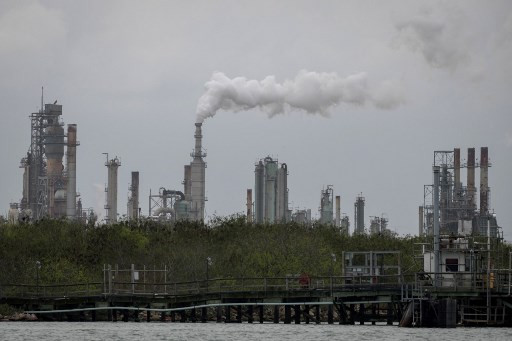Popular Reads
Top Results
Can't find what you're looking for?
View all search resultsPopular Reads
Top Results
Can't find what you're looking for?
View all search resultsOil claws back some losses after crashing on supply-demand shock
Futures in New York rose about 6 percent after losing a quarter of their value Monday in the biggest plunge since the 1991 Gulf War.
Change text size
Gift Premium Articles
to Anyone
O
il clawed back some losses after its biggest drop in three decades as investors grappled with simultaneous supply and demand shocks and the most volatile market on record.
Futures in New York rose about 6 percent after losing a quarter of their value Monday in the biggest plunge since the 1991 Gulf War. A gauge of volatility in the contract jumped to the highest in data going back to 2007 after the collapse of the OPEC+ alliance set off what could be a long and bitter price war.
Saudi Arabia slashed its official crude pricing over the weekend and is threatening to raise output to record levels, while Russia’s largest producer said it will ramp up production next month. The gush of new supply is happening as the coronavirus pummels global consumption, with the International Energy Agency warning crude demand will drop this year for the first time since the worldwide financial crisis.
Russian Energy Minister Alexander Novak indicated Moscow was prepared for a war of attrition, saying his country’s oil industry had “enough financial resilience to remain competitive at any forecast price level, and to keep its market share.” IEA Executive Director Fatih Birol warned that “playing Russian roulette in oil markets may well have grave consequences.”
The unprecedented supply-demand shock poses a serious threat to the US shale boom and oil-dependent economies in the Middle East, Africa and elsewhere. It sent shock waves across global markets, with US stocks plunging, Treasury yields dropping to records and credit markets buckling. Exxon Mobil Corp. dropped the most in 11 years, while Occidental Petroleum Corp. and Chevron Corp. suffering double-digit losses.
West Texas Intermediate crude for April delivery rose 5.2 percent to US$32.75 a barrel on the New York Mercantile Exchange as of 10:05 a.m. in Singapore after climbing as much as 6.6 percent earlier. It crashed by more than $10 a barrel on Monday to end at $31.13, the lowest since early 2016.
Brent for May settlement advanced 6.2 percent to $36.48 a barrel on the London-based ICE Futures Europe exchange after plummeting 24 percent on Monday. The global crude benchmark traded at a $3.32 a barrel premium to WTI for the same month.
The bounce in oil looks like “nothing more than a slight correction after the huge sell-off yesterday,” said Jeffrey Halley, senior market analyst at OANDA. “Nothing has changed with regards to the structural outlook for oil after the collapse of the OPEC+ grouping.”
Big banks including Citigroup Inc., Societe Generale SA and Goldman Sachs Group Inc. are warning oil prices could fall further. The IEA said Monday that oil demand is now expected to contract this year by 90,000 barrels a day and, in a rare move, included a more pessimistic scenario in which the demand loss would be many times more severe. In the US, the Energy Information Administration said it would delay the release of its monthly Short-Term Energy Outlook to allow time to “incorporate recent global oil market events.”
The shocks in supply and demand have also reverberated across time-spreads and options. Brent for prompt delivery collapsed against later shipments. The structure, known as contango, is a sign of bearishness and oversupply and makes it profitable for physical traders to buy crude and put it into storage, either in onshore tank farms or at sea on tankers.










